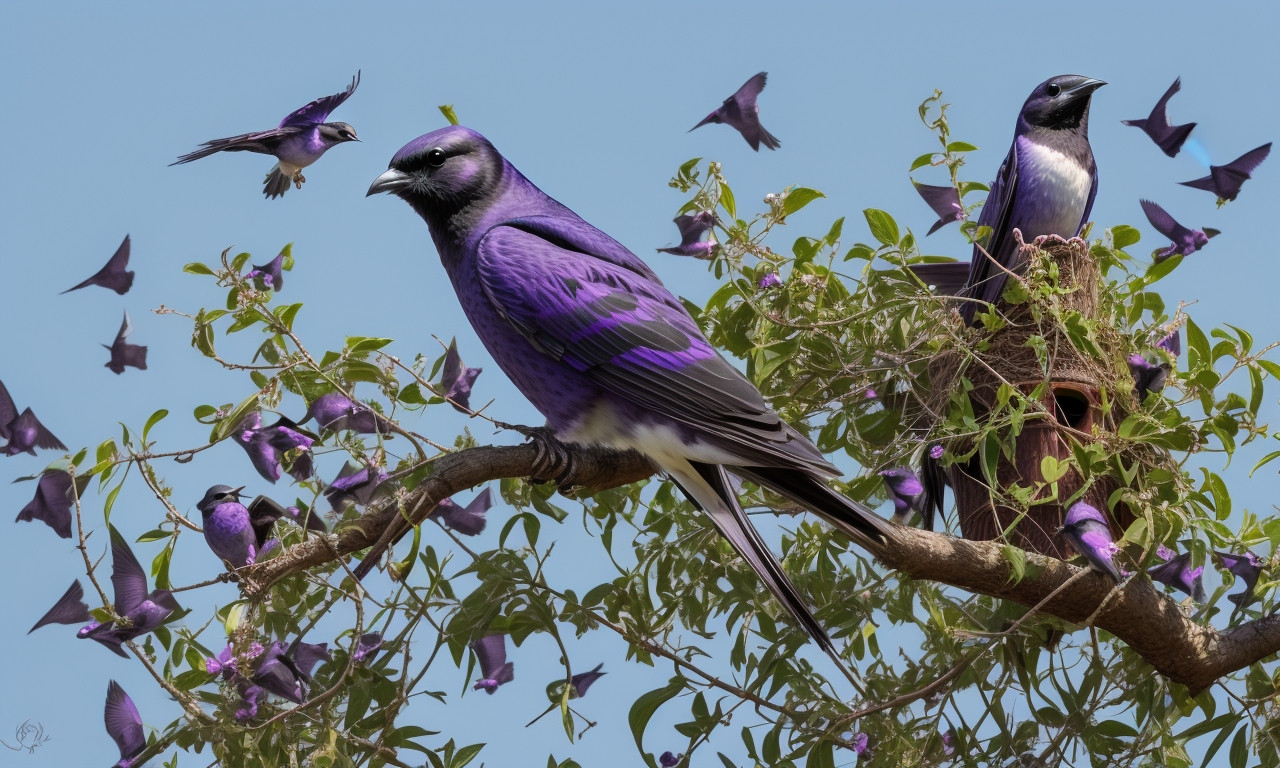Where Do Purple Martins Live? Discover Their Habitat, Distribution, Range now! Dive into the mesmerizing world of these fascinating aerial acrobats and uncover the secrets of their thriving communities. From their charming nesting boxes perched high in suburban backyards to the vast expanse of their migratory ranges, Purple Martins captivate bird enthusiasts and casual observers alike. Learn why these social songbirds choose particular habitats, understand their extensive distribution, and explore the fascinating journey that defines their existence. Prepare to be amazed as you explore the life of the Purple Martin like never before!
What is the distribution range of the Purple Martin?
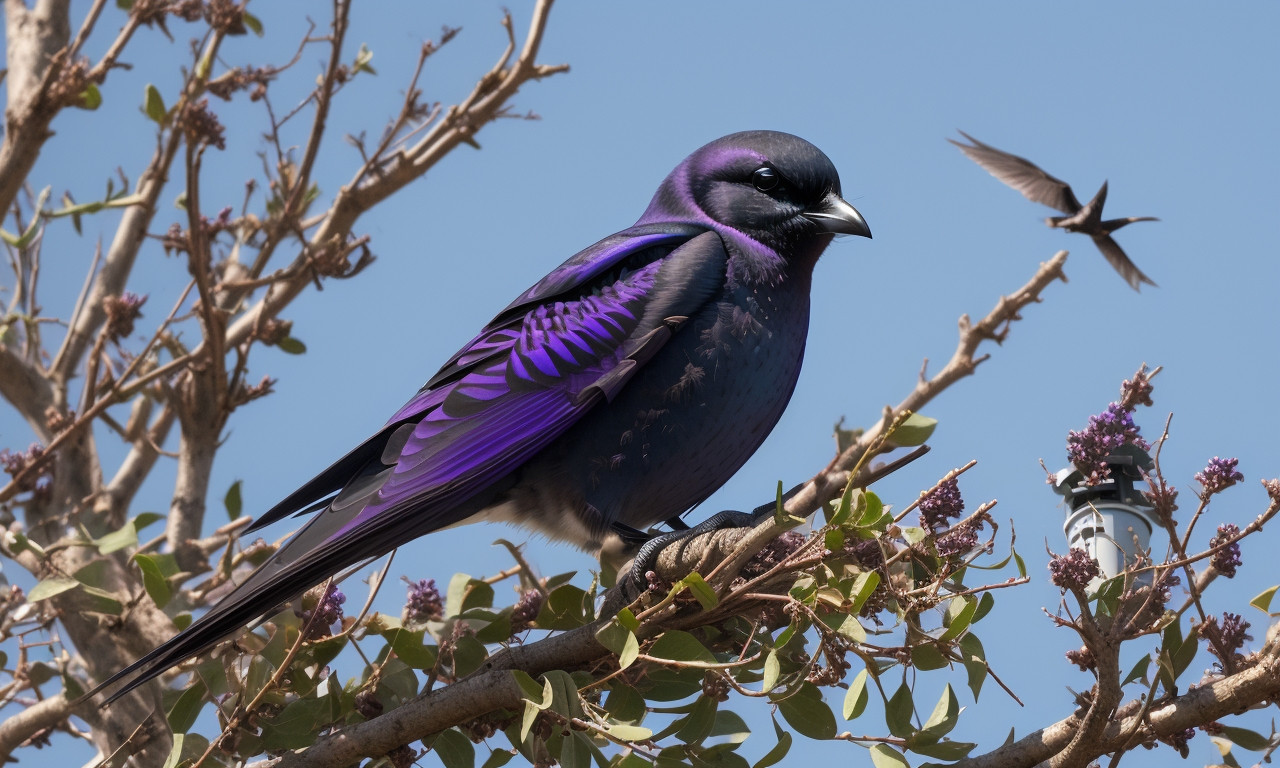
Purple Martins, North America’s largest swallows, are fascinating birds with distinctive homes. You may wonder, "What is the distribution range of the Purple Martin?" These agile fliers primarily inhabit North America’s eastern regions, extending from the Gulf Coast to southern Canada. In the west, they are less common but can still be found scattered along the western coastlines and into the Rocky Mountain region.
During the breeding season, Purple Martins seek open areas near water bodies, where they build nests in cavities. Historically, they preferred natural cavities like old woodpecker holes, but today, they predominantly nest in man-made structures such as multi-compartment birdhouses and gourds provided by enthusiastic birdwatchers. The communal nature of Purple Martins makes these housing solutions particularly effective, ensuring safer and more efficient breeding environments.
Come winter, these birds migrate to South America, particularly Brazil, where they enjoy the warm, tropical climate. This migration underscores their extensive range, encompassing diverse habitats across continents. Understanding "What is the distribution range of the Purple Martin?" reveals their impressive adaptability and the vital role that human-provided nesting sites play in their current distribution. Protecting and encouraging Purple Martins means supporting habitats crucial for their survival across their broad geographical range.
Breeding range
Purple Martins, a majestic species of swallow, captivate bird enthusiasts with their vibrant plumage and acrobatic flight patterns. Native to the Americas, these aerial insectivores exhibit a fascinating habitat preference. They typically inhabit open areas near water sources such as rivers, lakes, and coastal regions, where flying insects abound. The breeding range of Purple Martins extends primarily across North America, particularly in the eastern United States and southern Canada. During the breeding season, they favor artificial nest boxes or gourds provided by human hosts, contributing to their successful population maintenance.
In contrast, their non-breeding range spans vast distances as they migrate to South America, particularly Brazil, during the winter months. This seasonal migration is one of the most remarkable aspects of their life cycle, showcasing their endurance and adaptability. Their preference for human-made structures during the breeding range has led to a unique symbiotic relationship between Purple Martins and people, as many enthusiasts actively manage colonies to ensure successful reproduction.
Maintaining environments conducive to their nesting habits is crucial for their conservation. Understanding the breeding range and habitat preferences of Purple Martins enables better conservation strategies, ensuring these elegant birds continue to grace our skies annually. Efforts to preserve natural habitats and provide suitable nesting options will support their thriving populations for future generations.
Wintering range
Purple Martins, a beloved species of swallows in North America, inhabit a diverse range of environments, making for a fascinating study of their habitats. During the breeding season, these agile fliers typically nest in open areas near water, such as fields, meadows, and suburban gardens, primarily in man-made birdhouses or gourds. These settings offer ample food supply and open airspace for hunting insects.
However, their environment shifts dramatically post-breeding season. The wintering range of Purple Martins lies in South America, particularly in countries like Brazil, Bolivia, and Argentina. This migration is a spectacle, covering thousands of miles and driven by the search for warmer climates and abundant food supplies.
In their wintering range, Purple Martins prefer wetlands, forest edges, and savannas, habitats that provide both the necessary insect prey and roosting sites. Here, they gather in large flocks, sometimes numbering in the thousands, creating awe-inspiring communal roosts. The contrast between their North American breeding grounds and South American wintering range highlights their adaptability and the importance of diverse ecosystems in their life cycle. Understanding the varied habitats of Purple Martins not only emphasizes the need for conservation across continents but also enriches our appreciation of these remarkable migratory birds.
Where do Purple Martins live in the US?
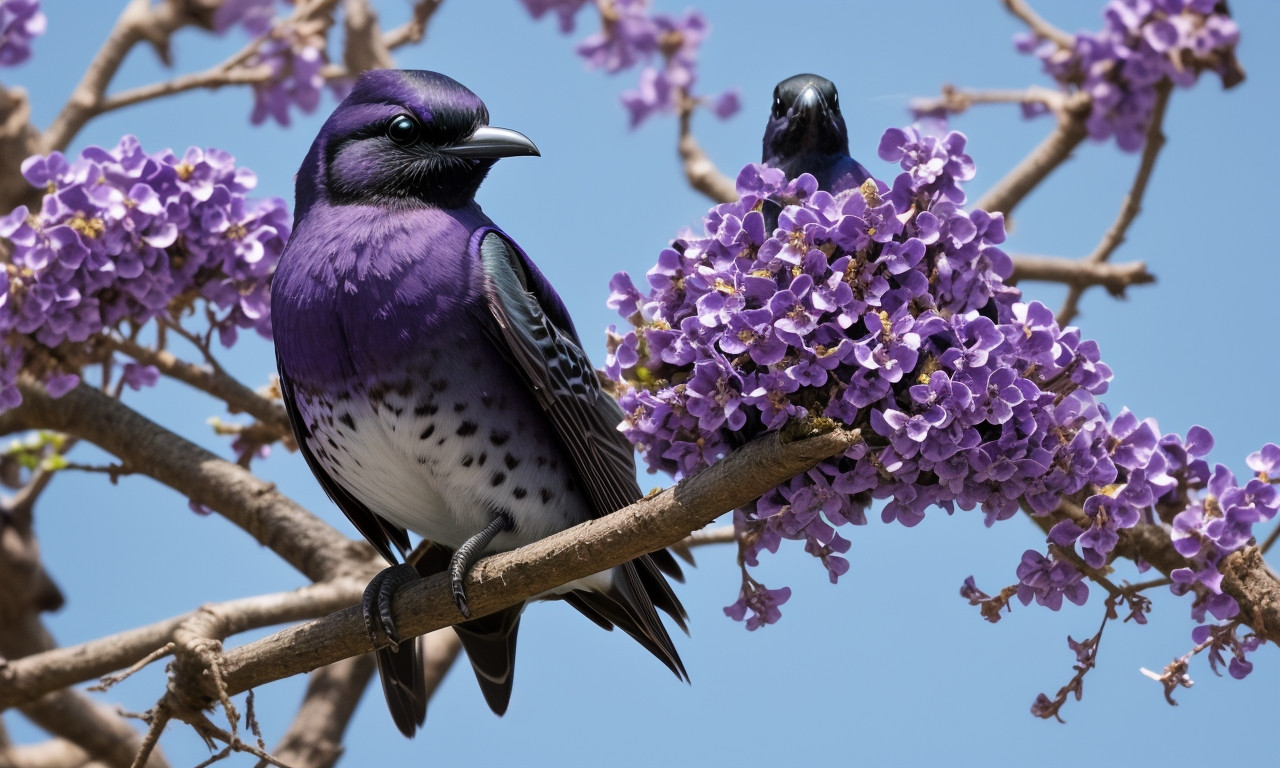
Purple Martins are charismatic migratory birds known for their distinctive purple plumage and impressive aerial acrobatics. These birds have a broad range across North America, with a particularly strong presence in the United States. So, where do Purple Martins live in the US? Their preferred habitats include open areas near water bodies such as ponds, rivers, and lakes. These environments are abundant in flying insects, which Purple Martins rely on for food.
In the United States, Purple Martins typically reside in man-made birdhouses, as natural nesting sites in tree cavities and old woodpecker holes have become scarce. The distribution of these birdhouses greatly influences their range, explaining why you’ll often find them in suburban backyards, parks, and agricultural areas, especially in the Eastern and Central states. States such as Texas, Florida, and the Carolinas often serve as robust territories for these birds.
During the breeding season, which starts in early spring, they flock to these regions to raise their young. However, as the season changes and winter approaches, Purple Martins migrate to South America, particularly Brazil, seeking warmer climates. Thus, the temporary nature of their stay in the US showcases their adaptability and affinity for diverse habitats ranging from urban landscapes to rural expanses. Where do Purple Martins live in the US? Their dynamic habitat choices paint a vivid picture of their continual journey across continents.
Where do Purple Martins live in Canada?
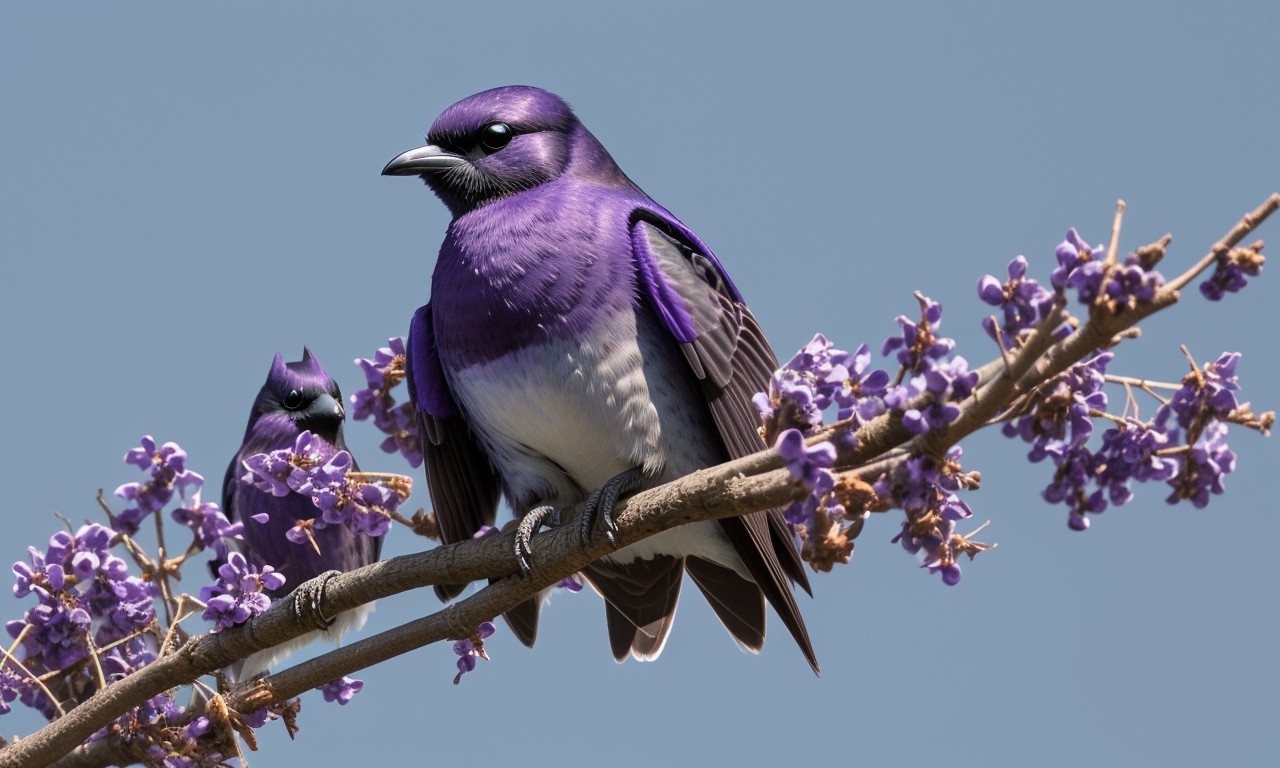
Purple Martins are a fascinating bird species known for their aerial acrobatics and glossy purple-black plumage. These birds primarily inhabit North America and can be found in various habitats across the continent. But where do Purple Martins live in Canada? In Canada, Purple Martins typically reside in the southern regions, especially in provinces like Ontario, Quebec, and British Columbia. They favor open areas near water bodies such as lakes, rivers, and wetlands, which provide abundant food resources like insects.
During the breeding season, you can often spot these birds in man-made nesting structures placed in fields, parks, and gardens. These structures, known as Martin houses or Purple Martin condominiums, are commonly erected by bird enthusiasts to attract these delightful creatures. This is particularly important because Purple Martins almost exclusively rely on human-made nesting sites in modern times.
These birds migrate to Canada from their wintering grounds in South America, particularly Brazil, arriving in late spring and staying through the summer. Their presence is a sign of the healthy ecosystem, as they help control insect populations. Understanding where Purple Martins live in Canada helps conservationists and bird lovers focus their efforts on providing suitable habitats to support these beautiful birds.
What is the habitat of a Purple Martin?
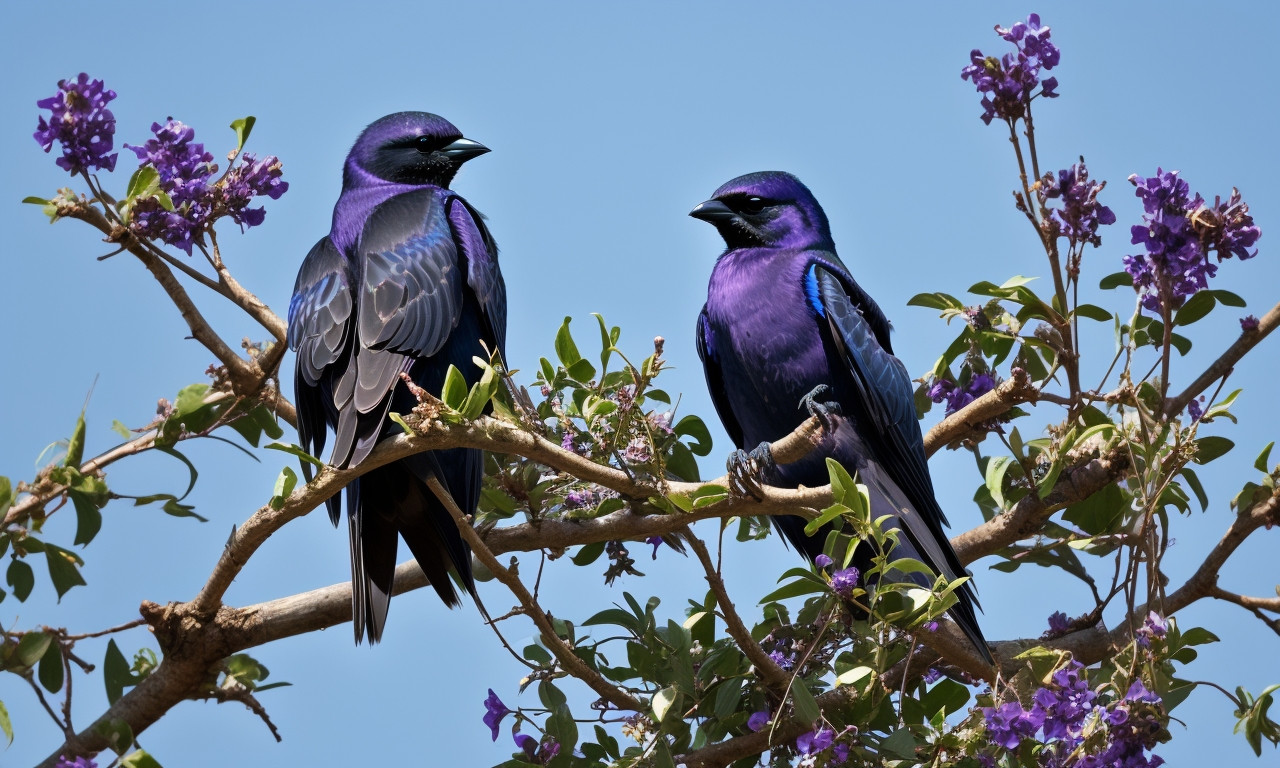
Purple Martins, North America’s largest swallow, are captivating birds known for their aerial acrobatics and melodious chirping. Understanding "What is the habitat of a Purple Martin?" is key to appreciating these migratory marvels. During the breeding season, Purple Martins predominantly reside in North America. They exhibit a preference for open areas near water bodies, including meadows, wetlands, and human-made structures such as birdhouses or martin houses. Historically, they nested in tree cavities, but now largely depend on artificial nesting sites provided by enthusiastic bird lovers.
When examining their habitat beyond the breeding season, Purple Martins migrate to South America, inhabiting countries like Brazil and Bolivia. Here, they are found in diverse environments ranging from tropical rainforests to open savannas. Their reliance on consistent water sources remains crucial throughout their range, ensuring ample food supply in the form of flying insects, which are fundamental to their diet.
The distribution of Purple Martins is extensive, spanning from southern Canada to Argentina. Their migratory pattern underscores the importance of suitable habitats across continents, emphasizing conservation efforts. The provision of proper nesting sites and the maintenance of insect-rich environments are essential for supporting the vibrant populations of these remarkable birds. Understanding “What is the habitat of a Purple Martin?” provides insight into the delicate balance required for their survival and proliferation.
How rare is it to see a Purple Martin?
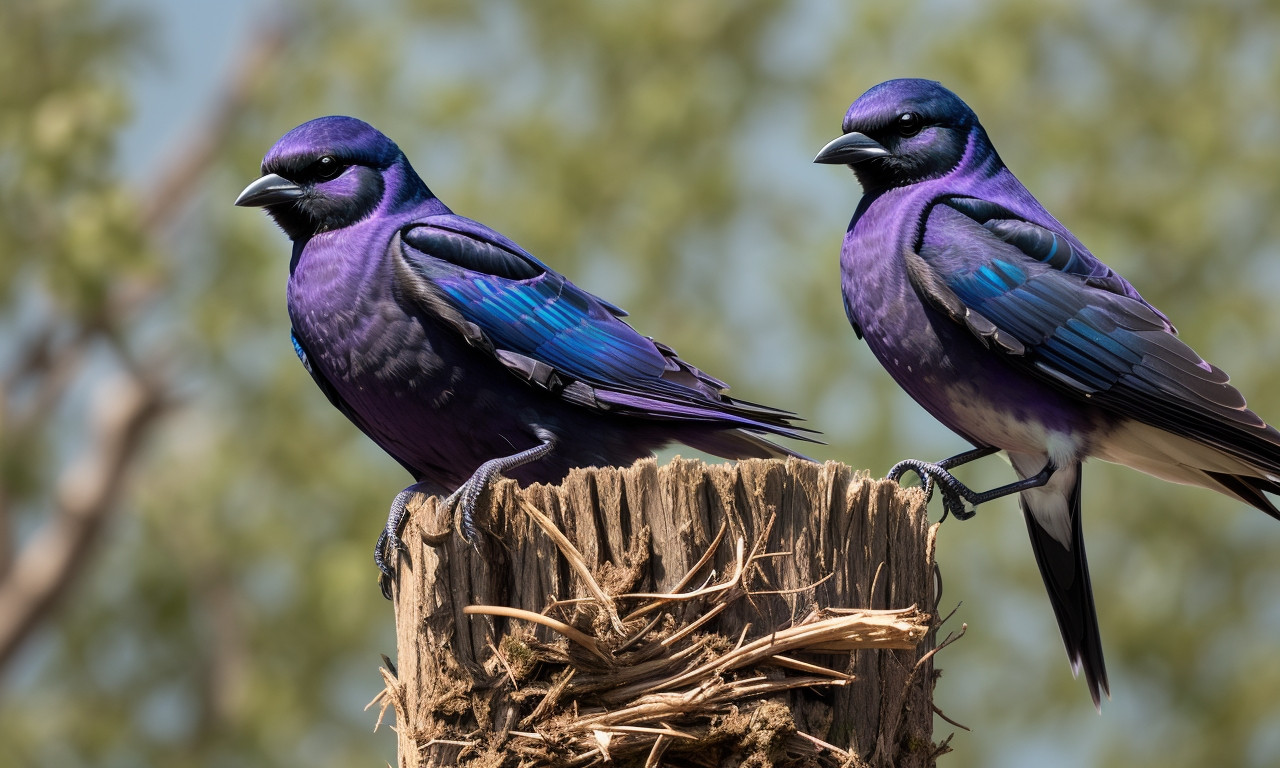
Purple Martins, the largest swallow species in North America, have a remarkable and varied habitat that draws enthusiastic bird watchers each year. These birds typically choose nesting sites close to human habitation where artificial nesting boxes and gourds are often provided. Naturally, they favor open areas near water, meadows, and fields, offering ample food supply and suitable flying conditions.
Their distribution spans from the east of the Rocky Mountains to the Atlantic Coast, stretching from southern Canada to the Gulf of Mexico. The western population is more scattered and prefers natural cavities in saguaro cacti or old woodpecker holes in Arizona and parts of the Pacific Northwest. During the winter months, Purple Martins migrate to the Amazon Basin in South America, where the climate is more favorable.
Regarding the question, "How rare is it to see a Purple Martin?", sightings can depend significantly on your location and the season. In areas with well-established colonies and suitable habitats, such as parks or backyards equipped with nest boxes, they are relatively common during the breeding season. However, in regions outside their primary range or in urbanized zones without nesting sites, spotting a Purple Martin can be quite rare. Bird enthusiasts often consider it a special treat to witness these agile fliers in action, signaling a healthy ecosystem and successful conservation efforts.
Where is the best place to see Purple Martin?
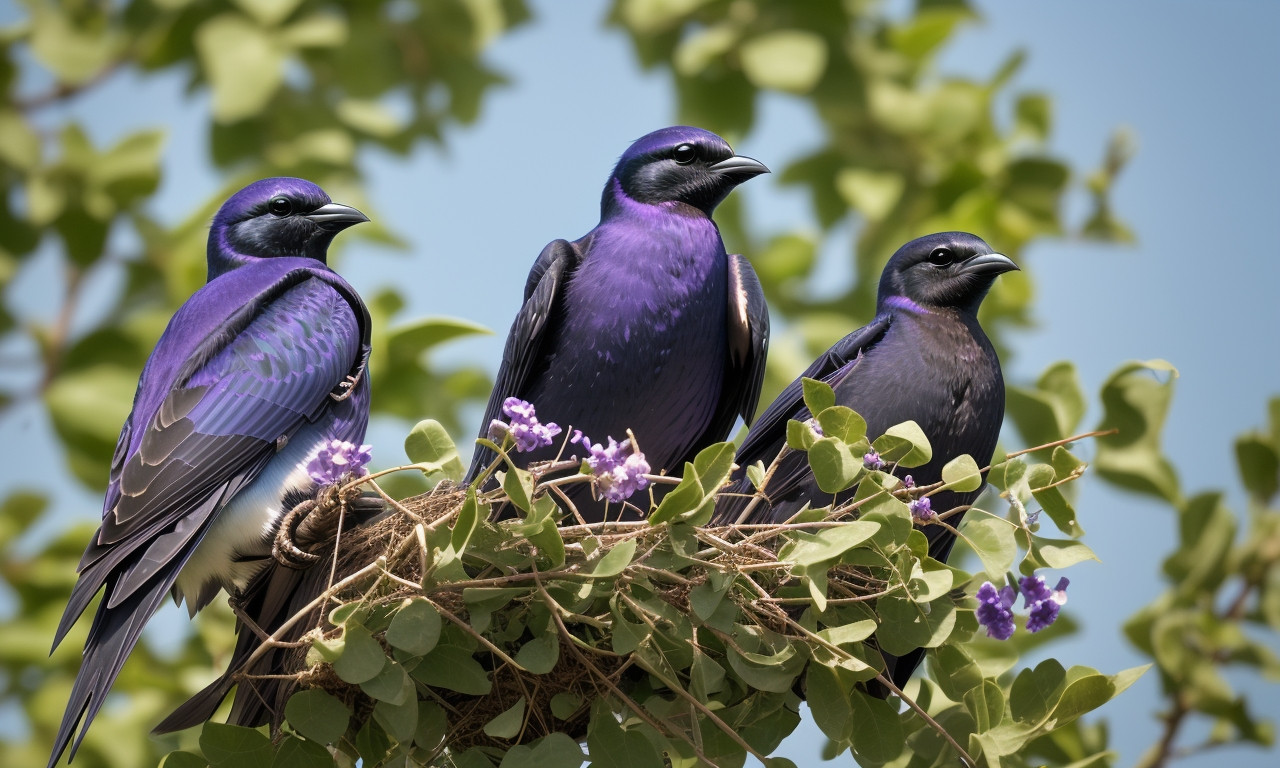
Purple Martins, known for their sleek blue-black plumage and joyful chirping, primarily inhabit North and South America. The best places to see Purple Martins in the United States are east of the Rocky Mountains, particularly in open areas where they can easily hunt for insects. They thrive in habitats that feature open fields, meadows, and near bodies of water. These birds are highly adaptable and often nest in man-made structures such as martin houses and gourds, which makes them unique among swallows.
In terms of distribution, Purple Martins migrate to South America during winter, with significant populations found in Brazil. During the breeding season, they return to North America, extending their range from Canada’s southern regions down to the Gulf Coast. The best time to observe these captivating birds is during their breeding season, typically from late spring to early summer.
One of the best places to see Purple Martins is at established Martin colonies, which can often be found in parks and wildlife refuges where devoted enthusiasts have installed housing. Some notable spots include Ohio’s Magee Marsh, Florida’s Lake Okeechobee, and Texas’s coastal regions. Thus, to witness the charm and grace of Purple Martins, these key locations provide ideal opportunities.
What time do Purple Martins come out?
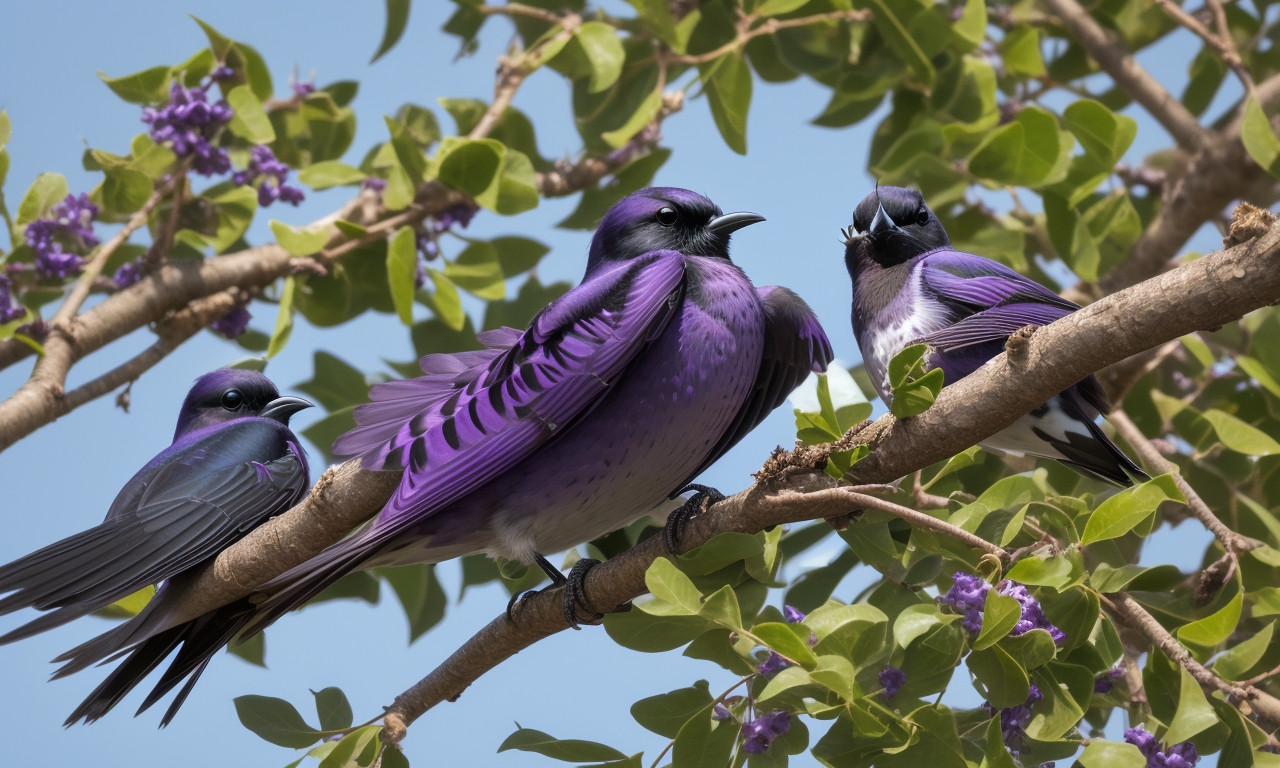
Purple Martins are small, migratory birds that predominantly reside in North America. They are known for their deep blue-purple glossy plumage and playful aerial acrobatics. Understanding their habitat involves recognizing both their preferred nesting sites and migration patterns. Purple Martins have a strong affinity for human-provided housing, often nesting in specially designed birdhouses or gourds. They thrive in open areas with plenty of flying insects to feed on, typically around lakes, ponds, or fields.
The geographical range of Purple Martins extends from the southeastern provinces of Canada, throughout much of the United States, to South America during the winter months. They first arrive in the southern U.S. as early as January in some places and move northward in waves. One commonly asked question is, "What time do Purple Martins come out?" These birds are highly diurnal, meaning they are active during daylight hours. They usually leave their roosts shortly after sunrise to forage and return by twilight.
Their daily habits are intricately linked with their environments, relying on both suitable nesting accommodations and healthy insect populations for sustenance. Consequently, Purple Martins serve as a natural indicator of ecological health in the regions they inhabit.
Do Purple Martins stay in one place?
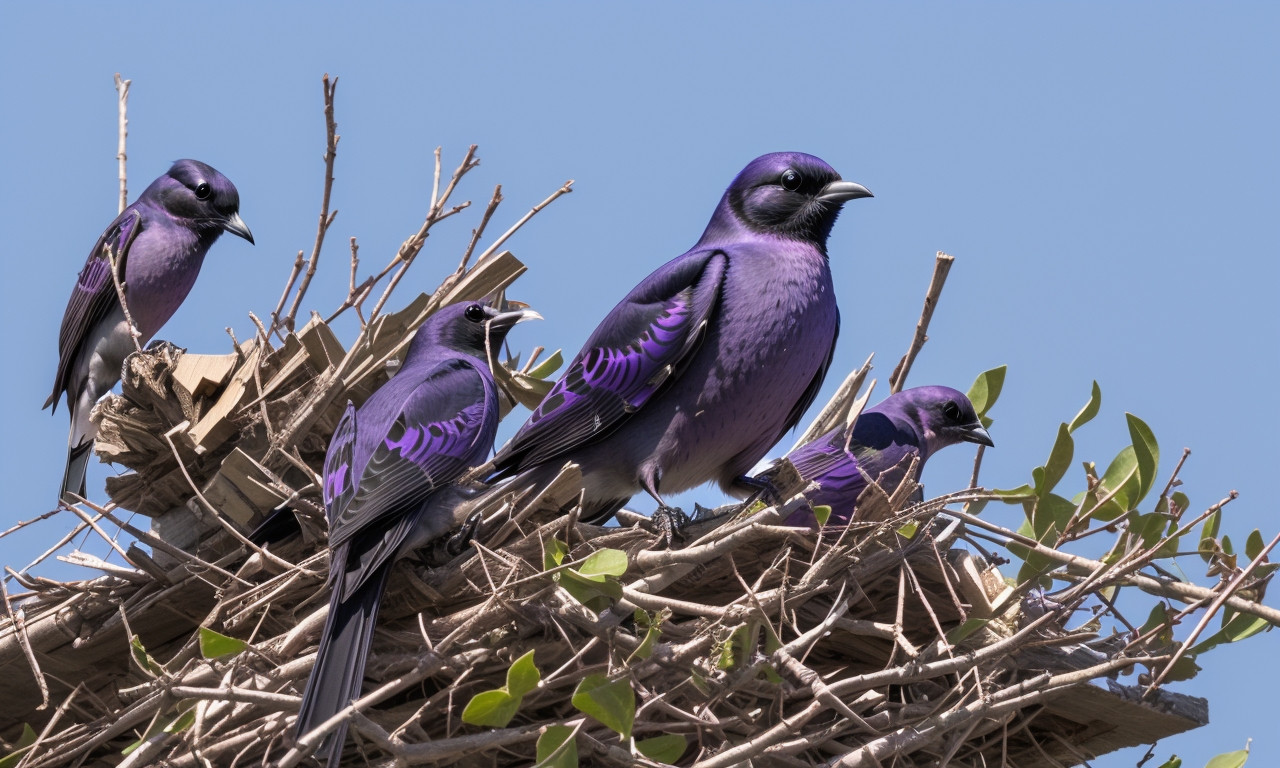
Purple Martins, the largest North American swallows, are renowned for their striking iridescent plumage and elaborate social behaviors. These birds are migratory, traveling impressive distances between their breeding and wintering grounds.
During the breeding season, Purple Martins predominantly inhabit the eastern United States and parts of southern Canada. They have a particular affinity for open areas near water, such as lakes, ponds, and rivers, where flying insects are abundant. Human-made structures, like birdhouses and martin condos, often serve as their nesting sites in these regions.
Once breeding season concludes, these avian travelers embark on a long migration to South America, primarily to countries such as Brazil, Bolivia, and Argentina, where they spend the winter months.
So, do Purple Martins stay in one place? The answer is no; their migratory lifestyle means that they occupy multiple habitats throughout the year. This dual-continent existence allows them to exploit seasonal abundance of food resources, ensuring their survival and reproduction. However, their dependency on specific habitats means conservation efforts are crucial to maintaining their populations across both North and South America. Understanding their habitat, distribution, and range helps to protect these fascinating birds and support their remarkable migratory journey.
Where do Purple Martins live in the winter?
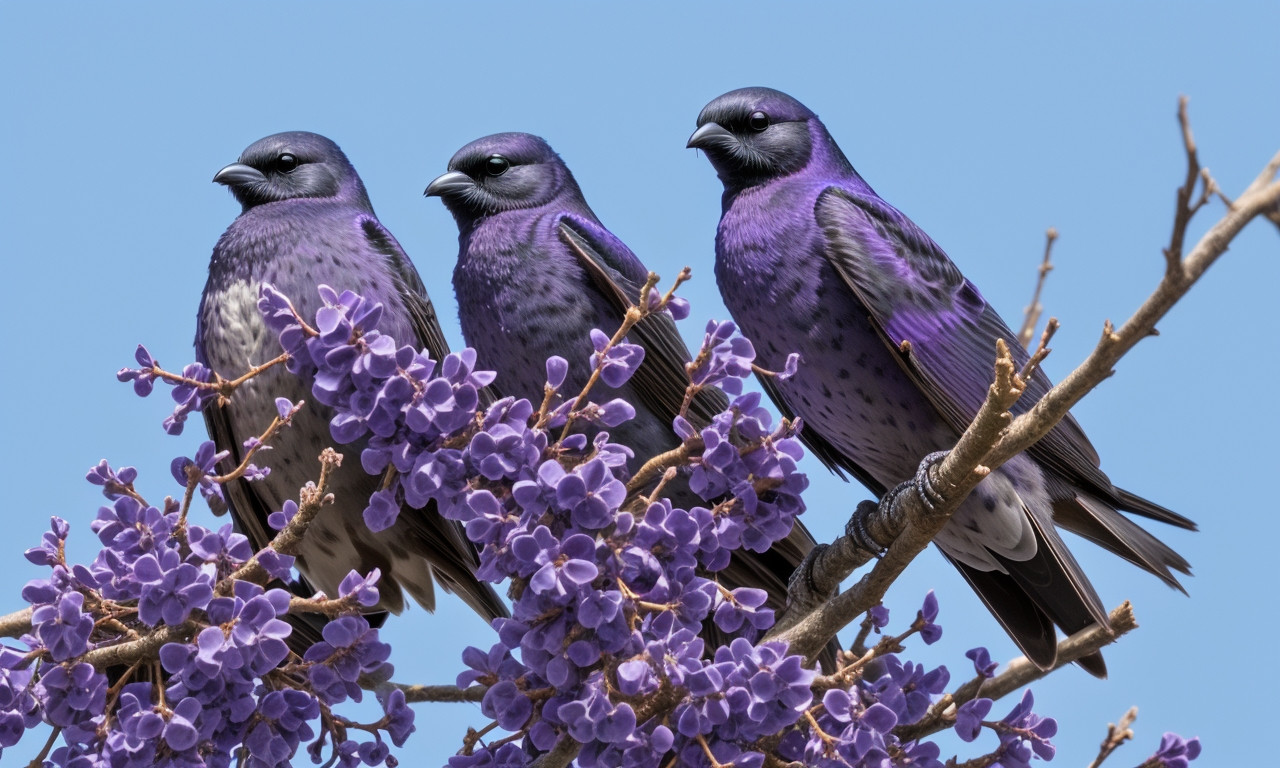
Purple Martins are fascinating migratory birds that captivate birdwatchers with their graceful flight and social nature. Primarily, Purple Martins breed in North America, favoring open areas such as meadows, fields, and near water bodies, where they nest in birdhouses provided by human enthusiasts or natural cavities. They are well known for their acrobatics and insect-eating prowess during the warmer months.
As fall approaches, these charming birds begin their migration journey. So, where do Purple Martins live in the winter? They embark on an impressive trip to South America, with many of them settling in countries like Brazil, Bolivia, and Venezuela. In these regions, they thrive in diverse habitats ranging from tropical rainforests to savannas, often seen roosting in large flocks. Their choice of wintering grounds provides them with ample food resources, such as flying insects, which are abundant in these warmer climates.
The migratory patterns of Purple Martins highlight their adaptability and resilience, demonstrating their ability to traverse vast distances. Observing these birds offers insights into the interconnectedness of ecosystems across continents. Understanding where Purple Martins live in the winter aids conservation efforts, ensuring that both their breeding and wintering habitats are protected for future generations to enjoy.
Where do Purple Martins live in the summer?

Purple Martins, with their glossy blue-black feathers, are a fascinating species of swallow native to the Americas. Recognized for their communal living habits, these birds establish colonies predominantly in human-made structures during the breeding season. But where do Purple Martins live in the summer? During this period, they are widely distributed across various regions in North America, especially in the eastern United States and southern Canada. Nesting primarily in birdhouses placed by enthusiasts, they thrive in open areas near water bodies, such as lakes and rivers, where they can easily hunt for insects.
In addition to these artificial structures, Purple Martins may also occupy natural cavities in dead trees, though such scenarios have become rarer due to habitat loss. Understanding where do Purple Martins live in the summer is crucial to their conservation. These birds rely heavily on human assistance for nesting sites in many parts of their range, making it important for people to provide suitable and safe nesting environments. As the summer ends, these intrepid travelers embark on a long journey to South America, completing a remarkable cycle of migration and showing the delicate balance between human intervention and natural wildlife behavior.
Do Purple Martins live in groups?
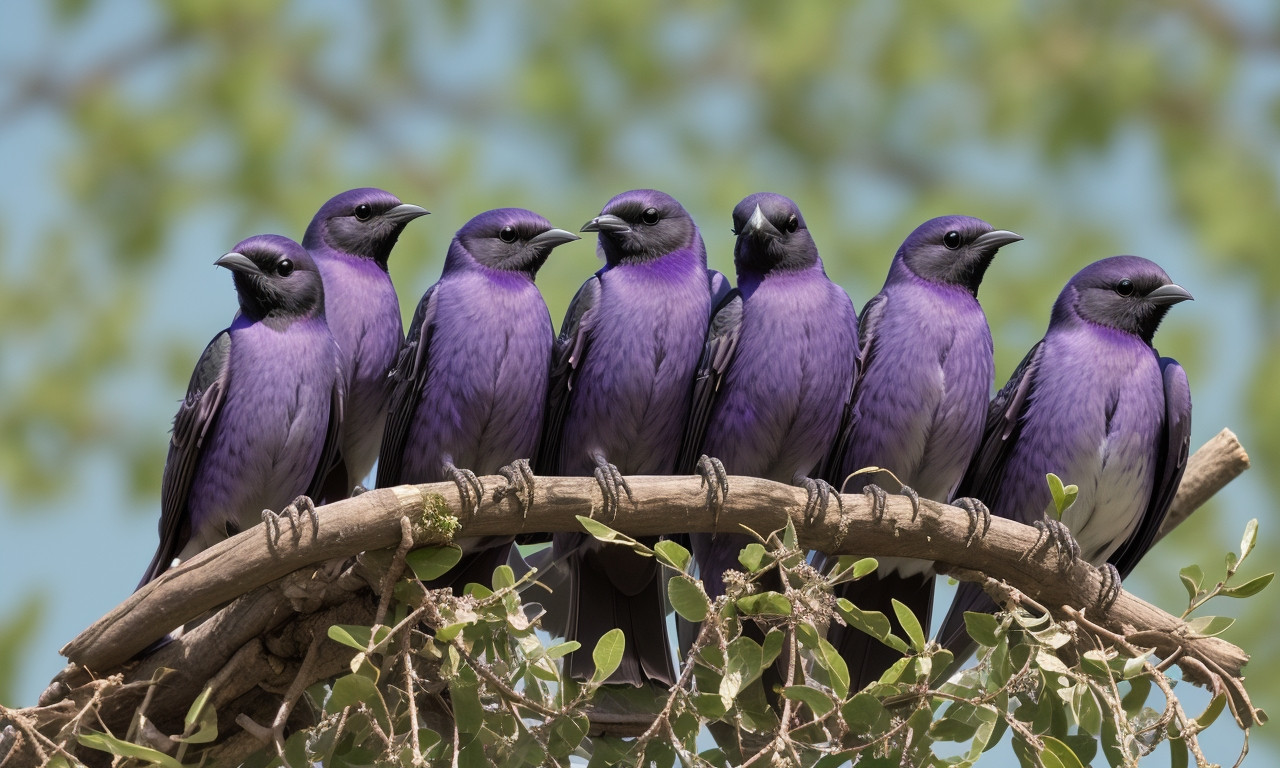
Purple Martins are fascinating birds known for their beautiful plumage and social behaviors. These birds are commonly found across North America, particularly in the eastern regions during the breeding season. In the winter, they migrate to South America, primarily to Brazil. One essential aspect of their habitat is their preference for open areas near water bodies, such as lakes, wetlands, and rivers, where they can easily hunt for insects.
So, do Purple Martins live in groups? Indeed, they do. Purple Martins are highly social birds that form communal roosts. During the breeding season, they congregate in colonies, often in man-made birdhouses or natural cavities. These colonies can consist of hundreds of birds, making for a bustling, dynamic community environment. This group living offers several advantages, including increased protection from predators and more efficient foraging.
Their preference for communal living extends even during migration when large flocks can be seen traveling together. The communal behavior is a defining characteristic of Purple Martins and is crucial for their survival and breeding success. Whether nesting in colonies or migrating in flocks, Purple Martins epitomize the importance of group living in the avian world.

